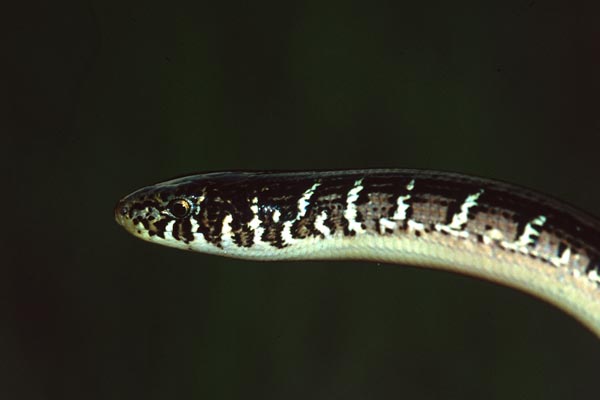Ophisaurus ventralis
—
Eastern Glass Lizard

Among the pygmy rattlers and other snakes we found this afternoon in Lake Woodruff, we also stumbled across two of these snake lookalikes. I found a large one that scurried off before we could grab it or take a picture. Dr. Terry Farrell found this somewhat smaller one a little while later. It was very anxious to be on its way and I had to settle for this flash photo -- Terry is holding the lizard just a few millimeters to the right of this frame.
Glass lizards have no legs, so many people would assume they are snakes. But unlike snakes they have ears and movable eyelids and various other anatomical features that show their lizardness. The name "Glass Lizard" comes from the ease with which their tails drop off at the slightest provocation. Some predators are distracted by the wriggling tasty tail, allowing the lizard to make its escape.
For more about the wildlife of Lake Woodruff, check out Dr. May's web guide to this refuge.
Printed references:
- Ashton, R. E. Jr., Ashton, P. S. 1991. Handbook of Reptiles and Amphibians of Florida, Part Two: Lizards, Turtles, & Crocodilians, Revised Second Edition
- Bartlett, R. D., Bartlett, P. B. 1999. A Field Guide to Florida Reptiles and Amphibians
- Behler, J. L., King, F. W. 1979. The Audubon Society Field Guide to North American Reptiles & Amphibians
- Carmichael, P., Williams, W. 1991. Florida's Fabulous Reptiles & Amphibians
- Conant, R., Collins, J. T. 1998. Peterson Field Guide to Reptiles and Amphibians of Eastern and Central North America, Third Edition, expanded
- Crother, B. I. (ed.) 2017. Scientific and Standard English Names of Amphibians and Reptiles of North America North of Mexico, with Comments Regarding Confidence in Our Understanding, Eighth Edition
- Smith, H. M. 1995. Handbook of Lizards: Lizards of the United States and Canada
- Smith, H. M., Brodie, E. D. Jr. 1982. Reptiles of North America: A Guide to Field Identification